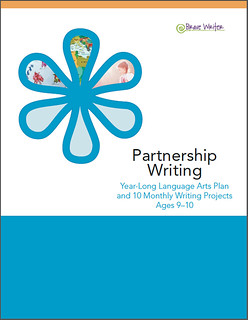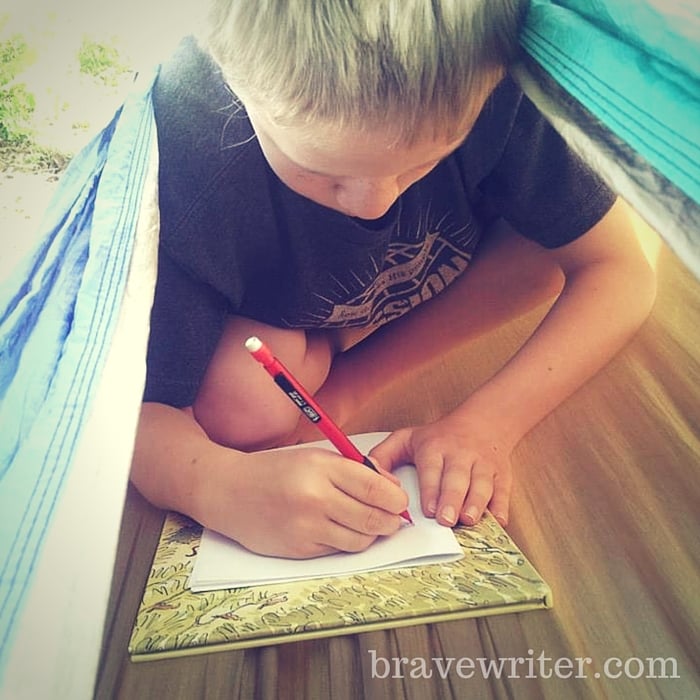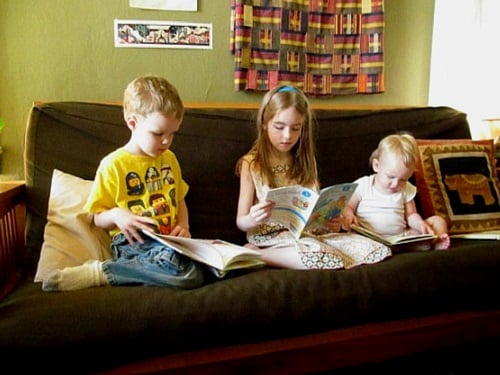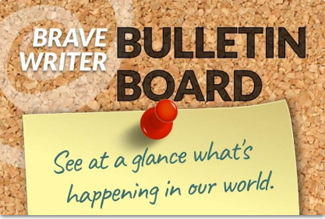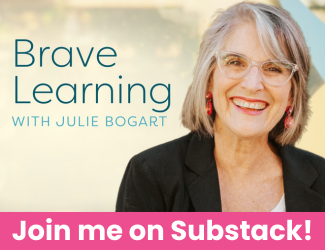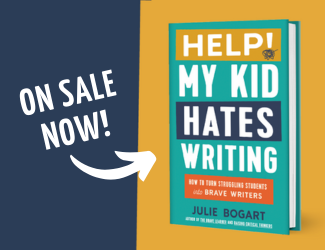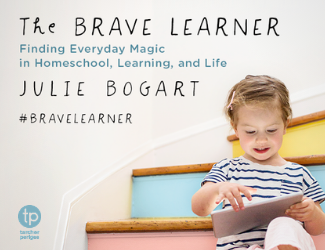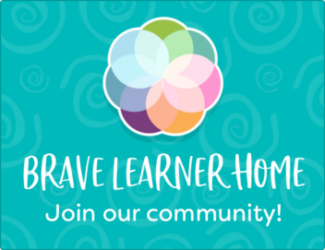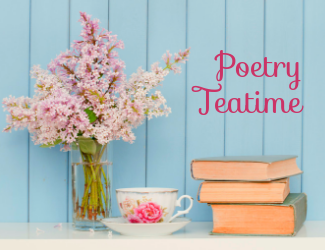Linda, mom of a very creative Brave Writer student, emailed me this fabulous photo. This is a perfect example of playing with language!
Archive for the ‘Young Writers’ Category
Partnership Writing is here!
Developmentally appropriate writing projects for your middlers.
Step-by-step instructions with models.
A weekly and monthly plan that puts it all together.
You got it!
Partnership Writing
The Year-Long Language Arts Plan
and 10 Monthly Writing Projects
(9-10 year olds)
Partnership Writing is the second in our series of products that gives you developmentally appropriate writing projects for your kids in the partnership writing stage of development. Jot It Down! is the first.
Have you wondered why your writing assignments stall? Do you wonder why your kids give you a blank stare after you ask them to fill a blank page? Do you have a tough time creating writing assignments that are both creative (interesting) and academically sound (preparatory for essay writing)?
And just how do you put together a program that includes copywork and dictation, as well as the language rich environment you hope to foster in your home, while still teaching original writing?
Partnership Writing tackles it all!
It can work alone (as a tool you use to boost the power of your writing efforts with your kids) and it can work in tandem with other Brave Writer products: The Writer’s Jungle (the manual that teaches YOU how to teach writing), and The Arrow (the tool that provides you with great literature to read, grammar, spelling and punctuation help, and copywork/dictation passages).
Plus we have special bundles on the website for Partnership Writing + The Writer’s Jungle and/or The Arrow.
To learn more about the Partnership Writing stage of development (usually 9-10 year olds, but also good for younger advanced writers and older kids who struggle), you can check out our Getting Started with Brave Writer page. You can also listen to a podcast by me where I explain what Partnership Writing is.
This is the perfect product for you if you need help thinking of writing projects and want to know how to plan them for a month at a time.
Professor Lena’s Guide to Modern Celery
Julie, I have been using your…writing activities in my school and the kids loved the drawing activity. Last week we did the senses activity using celery and I was surprised by the change in my 12 year old’s descriptions and her excitement to get started. She got her creative juices flowing and really stopped listening to the instruction but I consider what she wrote a success because she was engaged and interested. She was so proud of herself that she asked me to share it with you after typing it up herself. So here it is. Thank you.
Professor Lena’s Guide to Modern Celery
By Lena Kerley
I am studying celery, and someone else might say green, but I say it looks like layers of white with thin layers of sheer green leaf piled neatly together. On the inside it is bowled up like an Indians canoe, and paler than the outside where the sun reaches. On that side (the outside) the celery has small ridges that go down the stalk long ways. The leaves look like cilantro leaves, the way they appear old and wrinkled but also fresh and new. The smell is not my favorite, it reminds me of freshly cut grass and sweat. Currently beside me my seven year old brother is dissecting celery and showing some of the more hidden features, like if you cut the whole bunch at the base you will see a yellow flowery like piece. That is actually the leaves that have not yet emerged into view. He also describes the celery as feeling like a rubber hose. I have tried celery and don’t like the flavor so to learn about how celery tastes read Katie Kerley’s The Celery on the Table (not published) or Celery Puzzle by Pam Kerley (not published). I am honored that you (the reader) have made it to this sentence.
P.S. Celery is a good tool for annoying big sisters. (I am writing that as a big sister).
Tips for Young Writers
Tips for your young writers (ages 5-8):
1. The best curriculum for this age is still face paints and dress up clothes. Play, exploration, acting out—these teach. Trust the process.
2. Riddles, jokes, rhymes, poems, puns, secrets, mysteries, the alphabet (write it big, write it small, write it backwards, write it with chalk on the driveway, write it one letter per page, fit all the letters on a post-it note, write every other letter – not easy!), names (family, pets, streets, cities, imaginary friends, real friends, favorite characters). Play, explore, write, say, pretend with all of these, often, as much as you can.
3. For original writing: they talk, you write it down. End of discussion. Unless they are choosing to write their own thoughts on their own, you have no obligation to get them to write their own thoughts in their own hand by themselves. If they are writing their own thoughts, hug them—be a fan. Not a word of criticism about spelling, handwriting, story completion, or logic. Just kudos for the surprise of their self-starting joy!
4. For transcription: a handwriting book, simple copywork (one word a day can be more than enough for some kids), French dictation (explained in BW products), copying their own stories (only have them copy a paragraph, a sentence at a time, or more if THEY choose, but don’t require more in one sitting).
5. Read TO your kids OUT LOUD, everything you see—billboards, refrigerator magnets, ads in magazines you are paging through, funny comments on Facebook as you scroll through your feed, the text your husband just sent, the preface to a book, the instructions for the XBox, newspaper briefs, the side of the spice jar, the back of the muffin mix, the clever tag line on the shoe box… And yes, read quality literature aloud too. But read everything aloud… freely, often, commenting, laughing about it, noticing it.
6. Pair odious tasks with brownies and hugs.
7. Get outside, have big experiences, explore the world. For heaven’s sake, don’t worry yet. You’ll get to worry so much in the teen years and pine for these early years. So I’m here to tell you—play, explore, enjoy. Pick a fruit no one has ever eaten and eat it. Go to the zoo 3 times a week or the beach or the woods, if you dare. Make recipes for sludge and slime and baking soda volcanoes. No worrying.
That’s it. Really. Math isn’t my thing, but you can figure that out I’m sure. As my wise homeschool mom friend said to me: “Any math book teaches 1+1. Heck, we can do it ourselves.”
Also, our Jot It Down product is perfect for these ages!
Header image by Brave Writer mom Tiffany
Retelling: Details or Summary or Both?
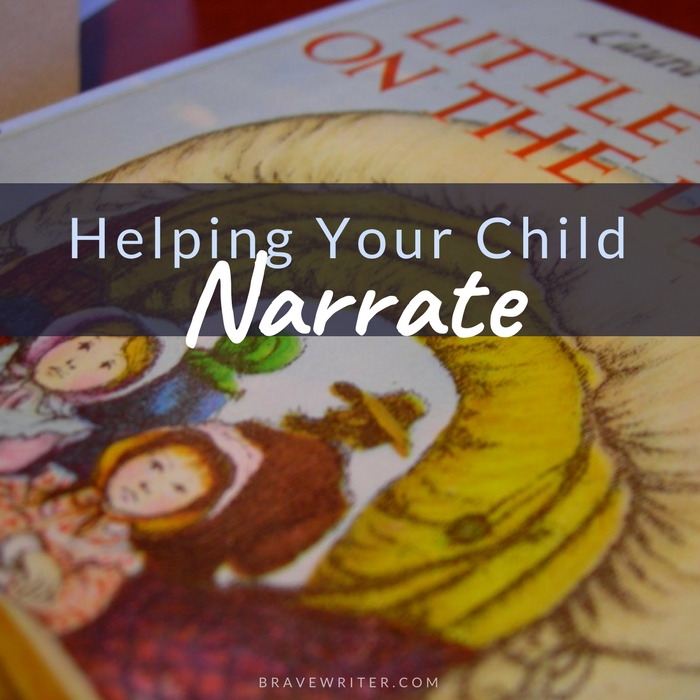
Great phone call today. Here’s the gist:
Mom: What do I do when my son [age 11] retells the details of a book or movie or story, but he can’t tell me the overarching narrative that goes with it? Like he can’t say the main plot points. He rambles and gets caught up in details that are non-essential to the plot, but he tells them with so much accuracy and depth, I hate to stop him.
My response:
Adults summarize. They can pick out the main points and sequence them. They’ve read 1000s of stories, watched as many films, and are well aware of the narrative arc (plot diagram) by virtue of time on the planet and years logged reading/absorbing “story.”
Kids don’t have this background, and can’t summarize like you. They’re younger. Story is fresh for them. They are beguiled by subplots and character quirks and twists. They chase the shiny object called “weapons,” “cute puppies,” “sassy friends,” “weird creatures,” “magic spells” or “epic battles” and report all that is filling their imaginations to the brink of enthusiasm. When you ask them to tell you about the story, the most exciting, fascinating points overflow. They can’t “sort” the images and emotions. They aren’t likely to sequence events into the narrative arc. They retell the memorable moments, with detail, reliving them in front of you.
Of course, most adults have completely lost the ability to trap details to that extent. Our brains are too busy for detail. We save the important markers and ditch the quirky dialog or style of weaponry. Children can retell with amazing accuracy. We have too many digits, words, experiences, memories, obligations in the way of uncluttered retelling. We hang onto the big picture and file it under “mental notecard” – as in, if asked, this is what I share.
Being able to summarize is a fairly sophisticated skill. It is possible to cultivate, but please don’t think it a superior skill to retelling in detail. For now, here’s how I want you to proceed:
Start by listening, really closely. Ask real questions that help you understand who, what, where, and when as the child relates the particular scene. You can jot down the responses on separate sheets of paper per scene or image or dialog. Keep these on a table in front of you. Ask for key details (names, places, why such-and-such happened).
Print a plot diagram (a simple one).
Then, with these notes in front of you both, ask some of these questions to help sort the information just shared:
1. Pick up one of the stories: Did this event happen at the beginning, or in the middle, or near the end of the story/film/book? Move the note you took to the right place on the table along the narrative arc. Do that for each of the scenes you’ve jotted down.
2. Ask the child what moment decided the outcome (the climax)? It may be difficult to identify the single one (there are lots of sub-plots in most stories). But the BIG one happens near the end. So direct your child’s attention to the end of the plot line. You can even discuss ones that were important along the way, but weren’t the final key determining factor. That’s a good conversation to have!
3. Talk about the characters. Which character is the most important to the story (without whom, there would be no story)? It’s usually obvious, but not always! The main character is called “the protagonist” and that is the one who is a part of the climax. We figure out who is important by how much we care about what happens to that character. A guide to identifying that character, then, is “Whose story do we care the most about?” Of course, your child may love a character in the subplot, but then you can expand backwards and say, “Who do you think the author wants us to care most about?” That will help differentiate.
4. Now talk about the antagonist (the character that wants to thwart the goal of the main character). Who stands to gain by interrupting the progress of the protagonist?
5. Lastly, ask about the events your child narrated to you. Are these related to the protagonist’s plight? Or are they about side-kick characters? If they are “side-kick characters,” we call these scenes part of the “sub-plot.” A sub-plot keeps the story interesting, adds detail to the main plot, and supplies a distraction or complication when the author needs one. Figure out whether the memorable scenes are plot or subplot.
Once you’ve collected this data, see if you can put it in a meaningful whole. You might narrate back to your child all the information you’ve collected and demonstrate what it means to put it in sequence. Once you’ve done that, you can ask your child to correct you, add to it, or try his/her own hand at it! Overtime, you can ask the child to take over and create the narration from this material from scratch.
What I hope you’ll take from this post:
Work with what your kids give you! Help them sort it out. Model what it looks like when it matches what you are hoping to hear. Then give them the chance to do it, with your help.
Do not abandon your child to your expectations and then wring your hands when they fail. Teach! That’s your job and your privilege.
 Our Arrow Book Club provides an online discussion space for students (ages 10-12) to discuss literature using literary analysis vocabulary without the pressure of writing “essays.” Homeschool students especially need the chance to talk about what they read—-yet the busy mother-of-many doesn’t always have time to take the discussion to a written form.
Our Arrow Book Club provides an online discussion space for students (ages 10-12) to discuss literature using literary analysis vocabulary without the pressure of writing “essays.” Homeschool students especially need the chance to talk about what they read—-yet the busy mother-of-many doesn’t always have time to take the discussion to a written form.
Images: Children reading by Brave Writer mom, Kort / Girl reading on bed by Personal Creations (cc)


